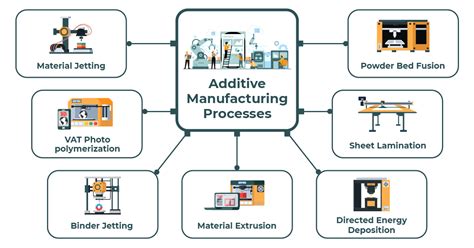additive manufacturing cnc The difference between additive manufacturing and CNC machining comes down to their core approaches: additive manufacturing builds parts layer by layer, offering design freedom and efficient prototyping, while . Simply put, “metal fabrication” is defined as creating products or structures by cutting, bending, and/or assembling metal material. It’s largely considered a value-added process as it consists of putting together actual products or structures from metal raw material.
0 · types of additive manufacturing processes
1 · machine learning in additive manufacturing
2 · examples of additive manufacturing processes
3 · additive manufacturing materials list
4 · additive manufacturing machines for sale
5 · additive manufacturing 3d printing machines
6 · additive manufacturing 3d printer
7 · 3d metal printing machine
When working with W.S. Tyler decorative metal fabrics, in particular, there are six weave pattern families that make up our mesh library. We’ll . See more
The difference between additive manufacturing and CNC machining comes down to their core approaches: additive manufacturing builds parts layer by layer, offering design freedom and efficient prototyping, while .Additive Manufacturing (AM) and CNC Machining can be combined together. Additive Manufactured parts can respond under stress differently than on-the-shelf materials due to the inner structure. With Additive Manufacturing (AM) .
For Keselowski Advanced Manufacturing (KAM), success with additive manufacturing happens on the so-called “subtractive” machines. The Statesville, North Carolina, company produces highly engineered metal . The difference between additive manufacturing and CNC machining comes down to their core approaches: additive manufacturing builds parts layer by layer, offering design freedom and efficient prototyping, while CNC machining subtracts material to achieve high precision, repeatability, and smooth finishes in production.Additive Manufacturing (AM) and CNC Machining can be combined together. Additive Manufactured parts can respond under stress differently than on-the-shelf materials due to the inner structure. With Additive Manufacturing (AM) material shaping process can be long. For Keselowski Advanced Manufacturing (KAM), success with additive manufacturing happens on the so-called “subtractive” machines. The Statesville, North Carolina, company produces highly engineered metal components for industries including aerospace and defense through laser powder bed fusion (LPBF) on 20 metal additive machines.
While both additive manufacturing and CNC machining work with metal to produce components, there are significant differences. Explore the processes & find which is best for your production.Additive Manufacturing (AM) and CNC (Computer Numerical Control) manufacturing are two dominant prototyping methods. Understanding the differences between these methods is crucial for businesses and designers looking to improve their new product development processes. A donut-shaped machine tool component called the AKZ FDS adapter illustrates the increasingly intricate links between additive manufacturing (AM) and CNC machining.
In the realm of modern manufacturing, CNC Subtractive Manufacturing (CSM) stands as the bedrock of precision, versatility, and top-notch surface quality. Conversely, Additive Manufacturing (AM) represents an exciting frontier for intricate designs, yet it faces limitations in industries that demand speed of manufacture, precision, material .Motivation and requirements for CNC machining to deal with additive manufacturing and its integration in machine tools CNC machining and additive manufacturing both have their advantages. Learn where AM is more beneficial, specifically for producing metal-forming dies.

types of additive manufacturing processes
Here is a rundown of these 3D printing processes along with how each can be used together effectively in a CNC machine shop. When additive manufacturing (AM) is applied in a precision turned parts machine shop it has been most commonly used to create tooling, fixtures and prototypes with polymer materials. The difference between additive manufacturing and CNC machining comes down to their core approaches: additive manufacturing builds parts layer by layer, offering design freedom and efficient prototyping, while CNC machining subtracts material to achieve high precision, repeatability, and smooth finishes in production.
Additive Manufacturing (AM) and CNC Machining can be combined together. Additive Manufactured parts can respond under stress differently than on-the-shelf materials due to the inner structure. With Additive Manufacturing (AM) material shaping process can be long.
For Keselowski Advanced Manufacturing (KAM), success with additive manufacturing happens on the so-called “subtractive” machines. The Statesville, North Carolina, company produces highly engineered metal components for industries including aerospace and defense through laser powder bed fusion (LPBF) on 20 metal additive machines.
While both additive manufacturing and CNC machining work with metal to produce components, there are significant differences. Explore the processes & find which is best for your production.
Additive Manufacturing (AM) and CNC (Computer Numerical Control) manufacturing are two dominant prototyping methods. Understanding the differences between these methods is crucial for businesses and designers looking to improve their new product development processes. A donut-shaped machine tool component called the AKZ FDS adapter illustrates the increasingly intricate links between additive manufacturing (AM) and CNC machining.In the realm of modern manufacturing, CNC Subtractive Manufacturing (CSM) stands as the bedrock of precision, versatility, and top-notch surface quality. Conversely, Additive Manufacturing (AM) represents an exciting frontier for intricate designs, yet it faces limitations in industries that demand speed of manufacture, precision, material .
Motivation and requirements for CNC machining to deal with additive manufacturing and its integration in machine tools CNC machining and additive manufacturing both have their advantages. Learn where AM is more beneficial, specifically for producing metal-forming dies.
machine learning in additive manufacturing
cnc machine burs
cnc machine bouwpakket
cnc machine car rims
examples of additive manufacturing processes
Aluminum, steel, and stainless steel are three of the most popular raw materials used in the construction of metal cabinets and each has a distinct set of properties and finishes across a wide range of performance and price points.
additive manufacturing cnc|additive manufacturing 3d printing machines